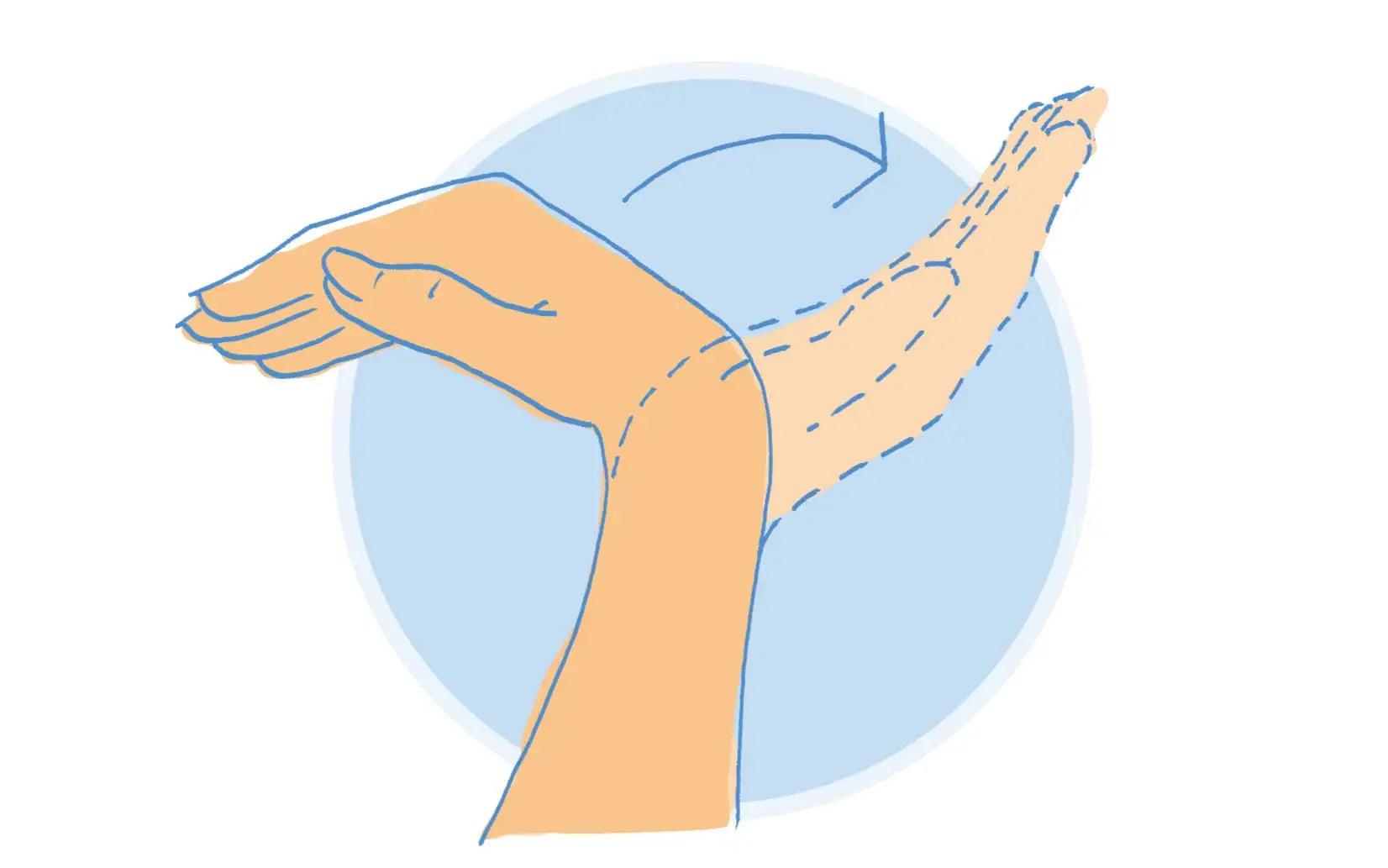Tingling in the hands, especially at night, numb fingertips or fingers and hands that fall asleep: when the typical symptoms of incipient carpal tunnel syndrome (CTS) appear, those affected should act quickly. If carpal tunnel syndrome is not treated, it can have serious consequences.
Around one in ten people in Germany are familiar with the symptoms of carpal tunnel syndrome, which usually begins with a harmless tingling sensation in the hands. Experts estimate that women are affected around five times more often than men. The problems usually occur between the ages of 40 and 70, initially mainly at night: you wake up because your hands are tingling because your hand has fallen asleep again or it hurts from your hand to your upper arm. After shaking, the pain and tingling disappear again.
What does tingling in the hands have to do with carpal tunnel?

Each arm is supplied by three nerves. They are responsible for motor function, i.e. movement, and for sensory function, i.e. the sense of touch and sensation. The middle arm nerve, the median nerve, is responsible for the sense of touch and sensation on the inside of the hand. In terms of motor function, it supplies a muscle of the thumb.
This median nerve runs from the shoulder via the upper arm and forearm. On the inside of the wrist, it runs through what is known as the carpal tunnel. This is a narrow tunnel at the level of the wrist, which is formed by the carpal bones and a tight band of connective tissue. In addition to the finger tendons, the median nerve also runs through this tunnel. This consists of sensory and motor fibers and certain hand muscles that supply the fingers and palms.
If this nerve is pressed or even pinched by its surroundings, the symptoms described occur. Most patients initially report a harmless tingling sensation in the hands, especially at night. If the onset of carpal tunnel syndrome is not treated, the nerve can be damaged in the long term.
If the symptoms are initially more sensory - the hand may tingle frequently, for example - motor symptoms may occur later, such as reduced strength in the fingers and especially in the thumb. The spectrum therefore ranges from a slight loss of sensation to permanent paralysis.
What are the causes of carpal tunnel syndrome?
In fact, no cause can be identified for the majority of carpal tunnel syndromes. It is referred to as idiopathic (ίδιος means "peculiar" in Greek, πάθος means "suffering") carpal tunnel syndrome.
This form occurs particularly frequently in women during the menopause and is attributed to water retention and tissue swelling in the carpal canal. Some people are predisposed to carpal tunnel syndrome because they have a narrow carpal tunnel from birth. Carpal tunnel syndrome develops if the same movement is constantly performed with the hand at work, if the wrist is subjected to heavy strain or if it is bent when sleeping.
Another possible cause is previous chronic tendon sheath inflammation or acute inflammation and swelling of the tendon sheaths. As these are also located in the carpal tunnel, they can press on the nerve. Very rarely, it is a hereditary disease that can affect children. Symptoms can also occur temporarily during pregnancy, as the body stores a lot of water during this time, which can increase the pressure on the median nerve.
Typical symptoms and progression of carpal tunnel syndrome at a glance
Most people affected do not take the symptoms of incipient carpal tunnel syndrome seriously enough: what could be wrong with your hands falling asleep at night?
Carpal tunnel syndrome symptoms are often not taken seriously
However, the longer the nerve in the wrist remains trapped, the more likely it is that permanent nerve damage will occur. Here is an overview of the symptoms:
- Carpal tunnel syndrome often begins with sensory disturbances in the thumb, index and middle fingers, as these are supplied by the median nerve. The typical carpal tunnel syndrome symptoms: The fingers feel numb, tingle as if they have "fallen asleep" and are painful.
- These symptoms often occur under stress and during the night. Reason for the nocturnal discomfort: Many people unconsciously angle their hand slightly when sleeping.
- In a next step, the symptoms of carpal tunnel syndrome become particularly noticeable when the hand is bent, for example when holding the telephone receiver or the steering wheel in a car.
- As carpal tunnel syndrome progresses, the discomfort intensifies, becomes permanent and the pain can radiate into the arm.
- At an advanced stage, the fingers become numb and the muscles of the ball of the thumb atrophy, i.e. they atrophy.
Carpal tunnel syndrome: symptoms in the early stages
The most typical sign of carpal tunnel syndrome in the early stages is that the fingers fall asleep at night. In the early stages, it is sufficient to reposition and shake the hand. If carpal tunnel syndrome remains untreated, the pain increases. These carpal tunnel syndrome symptoms are often accompanied by a tingling sensation in the palms of the hands. This is an unmistakable sign that the middle arm nerve, which supplies the inside of the thumb, the index and middle finger and the thumb-side half of the ring finger, is pinched.
The discomfort usually begins in a single finger and gradually spreads to the other fingers. If this pain first occurs after exerting the wrist, it later appears suddenly and without any recognizable cause.
Carpal tunnel syndrome: symptoms in later stages
The pain gradually moves up into the arm and shoulder. These carpal tunnel syndrome symptoms are accompanied by a deterioration in the sense of touch and sensation in the fingers. At this stage, it becomes increasingly difficult to button up items of clothing or pick up small objects. Soon the unpleasant sensations in the fingers disappear and they become numb instead. Gradually, a visible dent develops on the ball of the thumb - atrophy of the ball of the thumb.
This is because a muscle in the thumb, which is innervated by the affected nerves, gradually atrophies. This muscle atrophy severely restricts the function of the thumb. Because it can no longer be spread out, those affected find it difficult to pick things up or grip a bottle, for example. At this stage, the nerve is already severely damaged. If treatment is only started at this stage, it is often too late and the damage to the nerve can no longer be reversed. This can result in numbness in the palm of the hand and paralysis of the thumb.
Carpal tunnel syndrome: Do you have symptoms in both hands?
In most people with carpal tunnel syndrome, the carpal tunnel syndrome symptoms occur in both hands, one hand is often affected slightly earlier than the other. There can be months or years between carpal tunnel syndrome on one arm and the first symptoms appearing on the other. The right side, the dominant side, is affected more severely and more often in right-handed people and the left side in left-handed people. One of the reasons that carpal tunnel syndrome occurs earlier on the dominant side is that it is subjected to more stress.
Carpal tunnel syndrome: symptoms must be taken seriously and treated!
As with many other diseases, the course of carpal tunnel syndrome can vary greatly. Many sufferers experience moderate symptoms for many years, interspersed with long, symptom-free intervals. In such cases, there is a particularly high risk. If the early symptoms are not attributed to carpal tunnel syndrome, such sufferers only go to the doctor when the nerve is irreversibly damaged.
You can find out more about Curpal in the Focus Online report.







Leave a comment
This site is protected by hCaptcha and the hCaptcha Privacy Policy and Terms of Service apply.